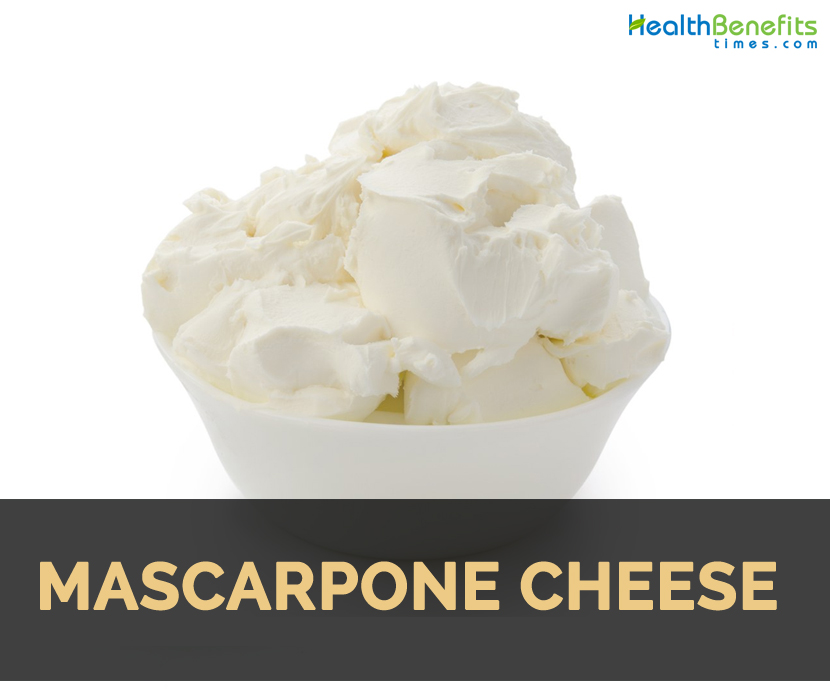| Mascarpone cheese Quick Facts | |
|---|---|
| Name: | Mascarpone cheese |
| Origin | Native to northern Italian region of Lombardy |
| Calories | 429 Kcal./cup |
| Major nutrients | Total Fat (122.46%) Calcium (14.30%) Protein (7.14%) Sodium (3.60%) Carbohydrate (2.75%) |
Mascarpone cheese is a fresh cheese made from cultured cream, native to the northern Italian region of Lombardy. Rather than beginning with milk, mascarpone starts with full-fat cream. This is gently acidified and cooked at a high temperature, which results in a markedly sweet taste and voluminous, fluffy texture.
This cheese is milky to white in color and also easy to spread. It is used for making Tiramisu and sweet stuffing. This soft cheese has high content of fat ranging from 60% to 75%. Mascarpone has smooth or creamy to buttery texture that depends on how it is processed during cheese making. It is used in both sweet as well as savory dishes. It is used to enhance the flavor of dish without overpowering the original taste. It goes well with mustard, spices, anchovies or combined with coffee or cocoa. It is also used to thicken dessert creams and puddings. It could be served with syrup or fruit. It should be consumed within few days or it will go bad.
History
Mascarpone is originated between Lodi and Abbiategrasso, Southwest of Milan, Italy, probably in late 16th century or early 17th century. The name is derived from mascarpa which is an unrelated milk product that is made from whey of stracchino or from mascarpia which is a term in local dialect for ricotta. Unlike mascarpone, Ricotta is made from whey.
How to make Mascarpone cheese?
What You’ll Need
Cream: 1 qt. (1 L) whipping cream (about 30% fat) or heavy cream (about 36% fat)
Acid: ¼–½ tsp. (1–2.5 g) tartaric or citric acid dissolved in ⅛ cup (30 ml) water
Equipment: Pot, spatula, thermometer, cheesecloth or organdy, colander
Process in a Nutshell
Time: 30 min. active, 16–24 min. inactive
Steps: Heat cream, add acid, drain, chill, store and use
Step by Step
Heat Cream: Pour the cream into the pot, and place the pot over medium-high heat. Heat the milk, stirring constantly and scraping the bottom of the pot with the spatula, until the temperature reaches 195oF (90oC).
Add Acid: Slowly drizzle the dissolved acid into the cream while stirring gently. Maintain the temperature of the cream at 195oF (90oC), stirring gently, for 10 minutes. Remove from the heat and cool to 100oF (38oC).
Drain: Position the colander over another pot and line with a double layer of cheesecloth or a single layer of organdy. Carefully pour the thickened mixture into the colander. Let the mixture drain at a cool room temperature of 65oF–70oF (18oC–21oC), stirring occasionally, until about the thickness of yogurt or sour cream, usually about 16–24 hours.
Chill: Cover and refrigerate the mascarpone until cold. It will continue thickening as it chills.
Store and Use: Store in the refrigerator for up to two weeks.
Troubleshooting
Mascarpone is pretty hard to mess up.
How to Eat
- It is used in Lombardy dishes.
- Use it as a spread.
- It is used to enrich pasta and soups.
- It is also used to thicken dessert creams and puddings.
- Mascarpone cheese is a vital ingredient in tiramisu which is a modern Italian dessert.
- Sometimes, it is used to thicken and enrich risotto.
- It is used in cheesecake recipes.
- Devour it over pancakes or combined with granola.
- It could be served with fresh fruit or used as a cake filling or topping for desserts.
- It is used alongside with brandy, espresso and chocolates.
- Mascarpone is used for making frostings, thicken puddings or cream for desserts.
- It is consumed in its own served with fresh fruit.
- Stuff the mixture of thyme, mascarpone, salt, lemon zest and pepper under chicken‘s skin before roasting.
- For plum tart, cut puff pastry (into rectangles) and bake till it becomes golden. Combine mascarpone with icing sugar to taste and a dash of balsamic vinegar. Then put spoonfuls of the Mascarpone mix on the top of pastry rectangles and top it with drained canned black doris plums.
References:
https://en.wikipedia.org/wiki/Mascarpone
https://www.cheese.com/mascarpone/
https://www.bbc.com/food/mascarpone_cheese
https://www.tarladalal.com/glossary-mascarpone-cheese-1519i
https://www.stuff.co.nz/life-style/food-wine/food-news/64004224/10-things-to-do-with-mascarpone
https://www.bhf.org.uk/heart-matters-magazine/nutrition/cheese/the-good-the-bad-and-the-ugly
Comments
comments
